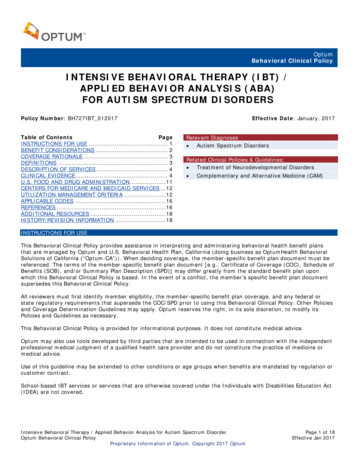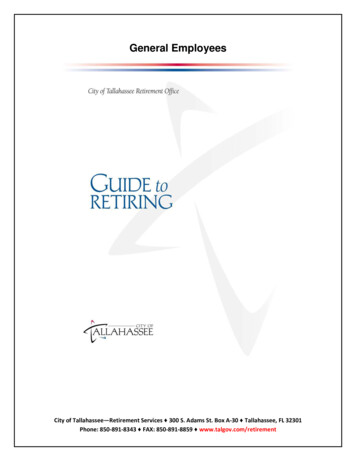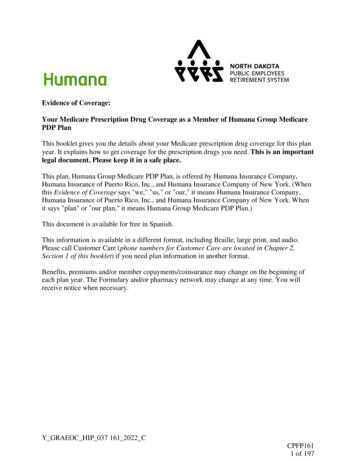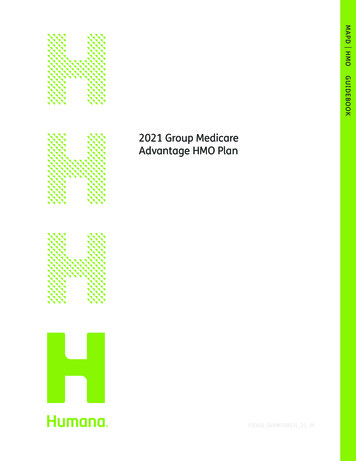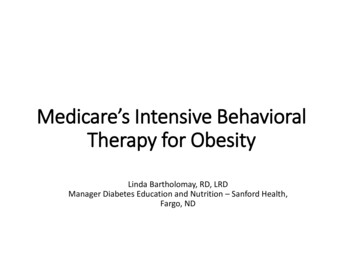
Transcription
Medicare’s Intensive BehavioralTherapy for ObesityLinda Bartholomay, RD, LRDManager Diabetes Education and Nutrition – Sanford Health,Fargo, ND
What is this benefit? November, 2011: CMS allows a benefit called“Intensive Behavioral Therapy” for obesity if aMedicare recipient has a BMI of 30 or greater. IBT providers include: primary care physicians,nurse practitioners, CNS, physician assistants
USPSTF The United States Preventive Services Task Force (USPSTF) foundgood evidence that body mass index (BMI) is a reliable and validindicator for identifying adults at increased risk for mortality andmorbidity due to overweight and obesity. It also good evidence thathigh intensity counseling combined with behavioral interventions inobese adults (as defined by a BMI 30 kg/m2) produces modest,sustained weight loss.
Comment period to CMS Studies providing evidence for IBT includedmultidisciplinary approaches – these providers(dietitians, psychologists, exercise physiologists,etc., are not included in the list of providers of thisservice - -despite their expertise in obesitytreatment) Despite comments made from multiple disciplines,the decision stood to reimburse primary care MDs,PAs and NPs
Reponses ResponseWhile CMS is providing coverage for additional preventiveservices, we believe it is important that these preventiveservices should be furnished in a coordinated approach aspart of a comprehensive prevention plan within thecontext of the patient’s total health care. Primary carepractitioners are characterized by their coordination of apatient’s comprehensive healthcare needs. Primary carepractitioners are generalists who are specifically trained toprovide primary care services. Other provider specialtiesmay provide patient care in other settings but do not offercare in the context of being the coordinator of the patient’shealthcare needs, not limited by problem origin ordiagnosis. Coordination of health services is especiallyimportant in the presence of the coexisting health issues ofour Medicare beneficiaries.
Primary care providers Access issues for patients to get appointments Feel that it is not their area of expertise to counsel patientson healthy eating, activity and behaviors Reimbursement for IBT is very low Would rather have other disciplines see their patients forweight loss
Survey of US Primary Care Physicians –published in BMJ Open 2012
What is the IBT benefit? Screening for obesity using BMI Dietary assessment “Intensive behavioral counseling and behavioraltherapy to promote sustained weight loss throughhigh intensity interventions on diet and exercise”
Qualifications to receive IBT BMI 30 Patients must be competent and alert atthe time of counseling Service is provided by a qualifiedprimary care provider in a primary caresetting
Primary Care Family Medicine, Geriatrics, General Practice Internal Medicine OB Pediatrics Mid-level practitioners (NP, PA, CNS) Cannot be provided by any other specialty or referred for this service byanother specialty Locations – must be an outpatient setting (clinic, hospital outpatient,physician office, state or local public health clinics)
Specifics 22 visits in 12 month period 1 visit per week in first month 2 visits per month through month 6 At month 6 – must document weight loss in physician office record. If has lost 3 kg (6.6 lbs) at that point, the patient can continue to be seen for thisservice through month 12 If has not – needs to wait 6 months and be reassessed by physician & if deemedappropriate, can start again Months 7 through 12 – seen once a month
Specifics continued Is an annual benefit – so can begin again if BMI isstill 30 BMI must be documented by using a ICD-9 V-Codethat corresponds to the BMI (or ICD-10 Z-code) Patient has no copay or deductible
Providing the service Can be provided by auxiliary staff under thesupervision of a primary care provider “Incident to” billing requirements Requires a PC provider be on-site at the time theservice is being delivered by auxiliary staff Service can be provided via telehealth, but if donethis way by auxiliary staff, a PC provider must stillbe on-site where the auxiliary staff is providing theservice to the recipient.
USPSTF’s 5A’s approach for eachencounter Assess – factors affecting choice of behavior changegoals or methods Advise – provide clear, specific and personalizedbehavior-change advice Agree – collaboratively select treatment goals
Assist and Arrange Assist – using behavior change techniques,help the patient achieve their agreed-upongoals by acquiring the skills, confidence, socialand environmental supports for change Arrange – schedule follow-up contacts.Provide ongoing support – changing treatmentplan as needed. May include referral to moreintensive or specialized treatment
G0447 (HCPCS code) Face-to-face behavioral counselingfor obesity, 15 minutes
Unknowns Description of the service did not specify ifcould be done in a group or individually Could you bill for more than one “unit” ofservice since the description says “15 minutes”if saw the recipient for 30 , 45 or 60 minutes
Dietitians Providing this service “incident to” Does the patient need to be seen by the referringprovider at the 6 month visit to document theweight loss to allow us to continue seeing thepatient from months 7 to 12? As the BMI changes, should the V-code bechanged? Patients were referred from Primary Care providersor mid-levels. Electronic referral was developed.
Lessons learned Our MAC advised that we should bill for 2 units of this service ifsaw the patient for 30 minutes. However Any claim submitted with more than one unit of G0447 wasdenied. Reason was that more than one of this service couldnot be provided per day. This service cannot be provided on the same day whereanother office visit or E/M service is provided – but can beprovided on the same day as Preventative Exam, DSMT, MNT
Lessons Learned continued Created a template for documentation designed around the 5 A’srecommended by the USPSTF Tried to get physicians to include V-Code in referral, but this wasrarely done Numbers of patients referred increased rapidly as word spread - even without any promotion of the service Route all notes back to referring provider Include in documentation the on-site provider for each day for eachclinic where dietitians are providing this service
Sought clarification from CMS Was hearing from others across the countrythat if they updated the V-Code for BMI asweight changed, services were denied onceBMI went below 30 CMS did respond (after a couple of months)that the V-Code submitted with the claimshould be the initial V-Code when the servicestarted.
Realities How INTENSIVE can this service be if limit a visit with the patient to 15minutes? Need at minimum a 30 minute time allowed Documentation of the 5 A’s takes time, so each visit also took additionaltime to complete documentation Dietitians had to monitor visits and when the 6 month time wasapproaching – assure that the patient lost 3 kg or more
Realities continued As the number of these patients increased, access todietitians for other MNT & DSMT became difficult Revenue from this service is poor – so financially,displaces potential MNT revenue, which is muchbetter As with all weight loss, some patients quit after a fewmonths “Snow birds” presented some challenges with timingof visits Not all patients are able to lose 3 kg by 6 months
Positives Some patients have done very well - - especially ifthey were seen for the maximum visits allowed in ayear Improved BG, Lipids and blood pressure in thesepatients have increased referrals even more No show rate is less with this group
BG Control and Hypertension or Lipid Disorders Patients with poor BG control – dietitians could also work on foodchoices to enhance BG control Hypertension or Lipid disorders – Medicare does not cover MNT forthese diagnoses. RDs could also work in food and exercise strategies tobenefit these health conditions
As of January 1, 2015 Medicare will cover IBTprovided in a groupsetting Unsure of covered Assumes a 30 minutegroup class Should improve accessif fewer visits areindividual Can provide somestructure with topicsHCPCS code G0473
Adult Weight Loss ProgramS9470 – “Nutrition Counseling” Structured visits similar to theMedicare IBT Visits with the dietitian everyother week then monthly overtime Family Practice physicianmedically manages patients Psychology led behavioralgroupsG0447 - IBT Individual visits with RD everyother week until month 6, thenmonthly after that Can participate in group classes ifdesire (self pay) Can attend Psychology led classes– Medicare covers Sees same FP physician and ismedically managed
Billing compliance advice: If we provide the same service and bill the same fee, we can use theG0447 code for Medicare recipients and the S9470 code for privateinsurers or self pay G0447 S9470 (Nutrition Counseling) With the new G0473 groups covered, these patients can go into theexisting group classes for the same fee as the privately insured patients.Now there will be no copay or fee for the Medicare patients. G0473 S9449 (Nutrition Class)
Results Since starting to track these patients in our electronic patient record –we have seen 380 patients since 7/2013. This does not include patientsin seen in our AWLP. On average, we see 115-120 unique patients per month for IBT Most patients reach the 3 kg weight loss by 6 month, but some do not For those in the program for a year or more –wt loss has been between10-30 lbs or more
Challenges Tracking results electronically. One incorrect weightentered in ER or other clinic area can skew results Need to separate results of those patients who havecompleted the year versus those who have just started or only attended a few sessions before quitting Scheduling enough classes to handle volume (ie: needat least 10-12 classes for 110-120 patients per month) Increasing staff as demand increases
Challenges continued Curriculum is defined for Adult Weight Loss Program, but not aset curriculum for the IBT only recipients Will likely use class curriculum from AWLP for the IBT onlypatients as well Ideally, incorporate exercise specialists Outcome data – share with Medicare and other payors todemonstrate effectiveness of ancillary staff when working withthese patients - - MDs still need to refer and, ultimately, are stillthe care coordinators for their patients
Questions?Thank you for your time today
References DHHS – CMS: Intensive Behavioral Therapy (IBT) for Obesity - ICN 907800January 2014 Decision Memo for Intensive Behavioral Therapy for Obesity atabase/details/nca-decisionmemo.aspx?&NcaName c ACAAAAAAIAAA&NCAId 253& Bleich SN, Bennett WL, Gudzune KA, et al. National survey of US primarycare physicians’ perspectives about causes of obesity and solutions toimprove care. BMJ Open 2012;2:e001871. doi:10.1136/bmjopen-2012001871
"Intensive Behavioral Therapy" for obesity if a Medicare recipient has a BMI of 30 or greater. IBT providers include: primary care physicians, nurse practitioners, CNS, physician assistants. USPSTF The United States Preventive Services Task Force (USPSTF) found
